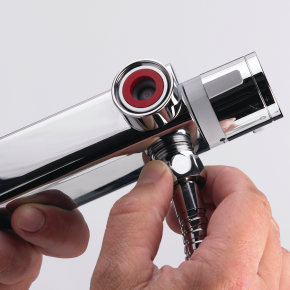
Stemming the flood – water efficiency in the home: A Bristan article
This article sees Chris Tranter, senior product manager at Bristan, look at the options regarding the clever solutions for balancing a satisfying bathroom experience with water efficiency.
With householders becoming increasingly aware of the efficiency of their homes, one of the core considerations within this is water usage. Many Brits prioritise multiple bathrooms and high-powered fixtures when looking for a new property, and as a consequence, our water bills are rising.
Environmental considerations and energy efficiency are a key part of building design and increasing awareness around these issues has led to a rise of a conscious consumer that takes an interest in green concerns such as water efficiency and sustainability.
In fact, according to the Environment Agency, the UK is facing water supply shortages by 2050 unless decisive action is taken now to reduce water use and wastage.
As a result, buyers are increasingly interested in the efficiency of a home’s water delivery products. If specified early-on, water saving options can be assessed and the most appropriate models selected and installed. If left to a later stage, the decision may be rushed and less efficient products chosen as an after-thought.
Also, housebuilders need to be aware of not only the most environmentally-friendly products, but also the cost-saving credentials of these. Essentially, if fixtures can be sourced which tick the boxes for both sustainability and cost-effectiveness, housebuilders can not only make responsible selections, but keep homeowners happy too.
So, what are the best water-saving, cost-efficient options?
The key is to balance customer requirements in terms of performance and water saving. One popular option is a flow regulator, which is included (as standard) in the design of certain models of taps and showers. These work by limiting the flow inside the connection, reducing water without making a significant impact on end user experience.
To put this into perspective, most standard showers distribute a flow rate of 13.5 litres per minute, whereas flow regulated showers offer a rate of 10 litres per minute – delivering significant water savings over the course of the year.
Another option is to fit a tap that offers subtle resistance at the halfway point, raising the user’s awareness of the flow. The good thing with both these options is that performance is not compromised.
As water scarcity becomes a bigger issue, it is imperative that greater measures are taken to ensure we minimise water waste. For housebuilders, making the case for water-saving products is not always a simple task, but by focusing the financial benefits of these solutions alongside their sustainability traits, a solution can be reached which is both environmentally responsible and householder-friendly.
Latest news

26th July 2024
Enfield Speciality Doors completes world-class project for Atlas Copco HQ
A rundown office and warehouse building completely transformed into a modern headquarters for Atlas Copco has been fitted with more than 120 internal fire doors from Enfield Speciality Doors.
Posted in Access Control & Door Entry Systems, Articles, Building Industry News, Building Products & Structures, Building Systems, Case Studies, Doors, Interior Design & Construction, Interiors, Posts, Restoration & Refurbishment, Retrofit & Renovation, Security and Fire Protection, Sustainability & Energy Efficiency, Timber Buildings and Timber Products, Wooden products
26th July 2024
Abloy UK launches new white paper
Abloy UK, a leading provider of security and access control solutions, has launched a new white paper.
Posted in Access Control & Door Entry Systems, Architectural Ironmongery, Articles, Building Industry News, Building Products & Structures, Building Services, Doors, Facility Management & Building Services, Health & Safety, Information Technology, Innovations & New Products, Publications, Research & Materials Testing, Security and Fire Protection
26th July 2024
MCRMA Member Profile: David Roy, Director of Roofconsult
David Roy of MCRMA member company Roofconsult has more than 50 years’ experience to draw upon working in the building envelope sector and a unique perspective on how it has changed in that time.
Posted in Articles, BIM, Infrastructure & CAD Software, Building Associations & Institutes, Building Industry News, Building Products & Structures, Building Services, Building Systems, Cladding, Information Technology, Restoration & Refurbishment, Retrofit & Renovation, Roofs, Walls
26th July 2024
Strand: Enhancing Door Functionality and Safety
Craig Fox, Sales Director for Strand Hardware, outlines how door industry professionals might apply door limiting stays…
Posted in Architectural Ironmongery, Articles, Building Industry News, Building Products & Structures, Building Services, Doors, Facility Management & Building Services, Health & Safety, Restoration & Refurbishment, Retrofit & Renovation
 Sign up:
Sign up: